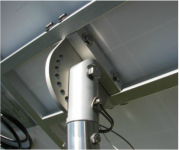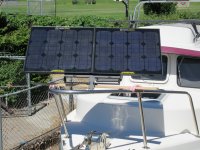thataway
Well-known member
- Joined
- Nov 2, 2003
- Messages
- 21,692
- Reaction score
- 63
- C Dory Year
- 2007
- C Dory Model
- 25 Cruiser
- Hull Identification Number
- DOR25652A707
- Vessel Name
- thataway
Foggy:
Cooler temperatures give more output. Generally solar panels are rated at 77* F (25* C), Each manufacturer will have a curve for the temperature vs output. For example:
Sharp Solar Panel NU-U230F3 is -.485% per 1 degree Celsius. So, for every degree above 25°C, the maximum power of the Sharp solar panel falls by .485%, for every degree above, it increases by .485%. Your panels may vary.
Dissimilar solar panels wired in parallel: you want to be sure that they are of the same voltage, and characteristics. Generally this means the same manufacturer as well as the same type of cells. If you wire dissimilar panels in series, they need to have the same current output, or they will be dragged down to the level of the lowest panel. If you are wiring two 12 volt dissimilar panels in series, you will have to use a MPPT controller, to get the 12 volts (instead of the 24 volts [actually more]). When you wire in series, you add the voltages, in parallel you add the current to get the output.
Thus, I would suggest that you use two similar panels--both voltage and current.
Hopefully you can find two 70 or 75 watt, 12 volt panels, which have the dimensions which allow you to use space most effectively. One trick I have seen is to mount the panels so that they can be hinged or articulated to both give the best azimuth, and use the space most effectively, rather than lying flat on the cabin top.
For example C Puffin has two panels on a SS pole which move in 2 planes;

The panels can be single mounted on a articulated mount, on a short piece of SS tubing, or even on a railing...Many options. For example you can get a 26.57 × 30.47, 70 watt panel. Maybe one on each side. You can put slightly off the roof on short or even fold down (think the 1: SS radio antenna ratchet mounts, which you can easily thread a 1" x 12" SS tubing onto, and then thread a ball mount for the panel on the top. When cruising, you can set the angle of the panel for optimal output. When trailering, or storing, down, but still close to horizontal to get very good output if desired.
Here is a link to custom made systems, similar to what I suggested.
 These are fairly expensive, they can be made for much less. Got me thinking--maybe something like my "Commode" mount using Home Depot pieces... :lol:
These are fairly expensive, they can be made for much less. Got me thinking--maybe something like my "Commode" mount using Home Depot pieces... :lol:
....* Better in warm solar cell temperatures (45* - 75*C = 113* - 167*F !!!)
[ Keep those panels cool? Why?]
Cooler temperatures give more output. Generally solar panels are rated at 77* F (25* C), Each manufacturer will have a curve for the temperature vs output. For example:
Sharp Solar Panel NU-U230F3 is -.485% per 1 degree Celsius. So, for every degree above 25°C, the maximum power of the Sharp solar panel falls by .485%, for every degree above, it increases by .485%. Your panels may vary.
Dissimilar solar panels wired in parallel: you want to be sure that they are of the same voltage, and characteristics. Generally this means the same manufacturer as well as the same type of cells. If you wire dissimilar panels in series, they need to have the same current output, or they will be dragged down to the level of the lowest panel. If you are wiring two 12 volt dissimilar panels in series, you will have to use a MPPT controller, to get the 12 volts (instead of the 24 volts [actually more]). When you wire in series, you add the voltages, in parallel you add the current to get the output.
Thus, I would suggest that you use two similar panels--both voltage and current.
Hopefully you can find two 70 or 75 watt, 12 volt panels, which have the dimensions which allow you to use space most effectively. One trick I have seen is to mount the panels so that they can be hinged or articulated to both give the best azimuth, and use the space most effectively, rather than lying flat on the cabin top.
For example C Puffin has two panels on a SS pole which move in 2 planes;

The panels can be single mounted on a articulated mount, on a short piece of SS tubing, or even on a railing...Many options. For example you can get a 26.57 × 30.47, 70 watt panel. Maybe one on each side. You can put slightly off the roof on short or even fold down (think the 1: SS radio antenna ratchet mounts, which you can easily thread a 1" x 12" SS tubing onto, and then thread a ball mount for the panel on the top. When cruising, you can set the angle of the panel for optimal output. When trailering, or storing, down, but still close to horizontal to get very good output if desired.
Here is a link to custom made systems, similar to what I suggested.
 These are fairly expensive, they can be made for much less. Got me thinking--maybe something like my "Commode" mount using Home Depot pieces... :lol:
These are fairly expensive, they can be made for much less. Got me thinking--maybe something like my "Commode" mount using Home Depot pieces... :lol:
